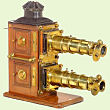 |
Sorts of Magic
Lanterns. Plural Magic Lanterns |
||||
| Select another sort of magic lantern by clicking one of the images below: | |||||
 |
 |
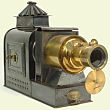 |
 |
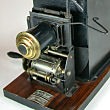 |
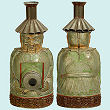 |
|
Plural lanterns.
These large
magic lanterns were
mostly made of wood and brass and consisted of two or three single lanterns
that were placed on top of each other or sometimes placed side by side. By projecting two or more magic lantern slides at the same time amazing optical effects could be performed, like dissolving views. The double magic lanterns made of mahogany and brass (biunials) were mainly made in England. Some well known manufacturers are Walter Tyler and Newton & Co. | |||||
|
Because of the wide
variety of magic lanterns it is almost impossible to classify them in
categories. There will always be borderline cases and exceptions and we
always could class many of them under several groups. Besides many models were launched in several sizes and in that case we could classify the smaller ones as toy lanterns and the bigger ones as parlour lanterns. Nevertheless we will have a try. Toy lanterns or Children's lanterns. These magic lanterns have small dimensions, have a plain construction and were cheap. They originally were provided with a candle or a small oil lamp as source of light. They are only suitable for showing small magic lantern slides of about 2 till 4 cm wide. Parlour lanterns. These lanterns are already a bit larger, have a more solid construction and are consequently more expensive. Because of the larger and more dangerous oil lamps they must not be considered as a toy. Larger lanterns. The kind of magic lanterns that were used to present lectures in large rooms and for teaching students at schools or university. Plural lanterns. These lanterns were mostly made of wood and brass and consisted of two or three single lanterns that were placed on top of each other or sometimes placed side by side. Thus amazing effects could be performed, like dissolving views. Special lanterns. By this we understand among other things the magic lanterns that are able to show not alone glass magic lantern slides, but also films or non-translucent cards or films, like the cinematographs and episcopes. Also remarkable lanterns like the lamposcope and the street lantern are classed here. Fancy lanterns. An exclusive category is build by magic lanterns that are not recognisable as a magic lantern at first sight because they are disguised as something else, like a Buddha, a mosque or an Eiffel tower. |
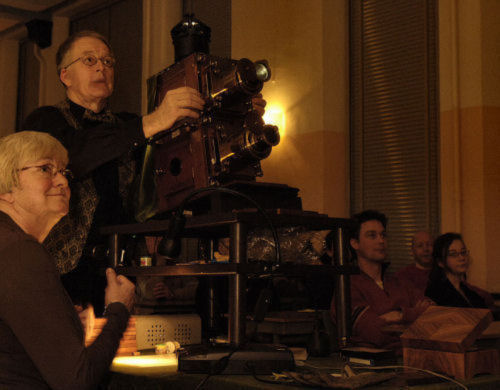 Most of the modern lanternists use a biunial for their magic lantern shows. Here we see the well known Dutch lanternist couple Daan Buddingh and Ankie Menger from Haarlem working hard with their beautiful double magic lantern from 1892. |
||
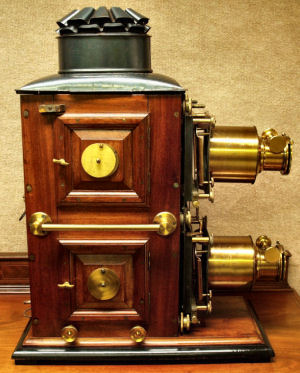 The lantern is 65 cm tall, 49.5 cm long en 24 cm wide. |
Rare biunial,
made of solid mahogany and brass. Using this kind of magic lanterns
lanternists at the end of the 19th century were able to incorporate
amazing effects in their shows, like
dissoving views,
effectplaten en
chromatroop-figuren. This magic lantern was probably made around 1890 by the English manufacturer Wrench. The focal distance of both lenses is 5" (15 cm). Two condensers are located inside the lantern. Nowadays the original oil- or gaslamp-lighting is nearly always replaced by modern halogen lamps. Dissolving from one lantern part to the other is mostly done by means of a electronic dimmer switch in those cases. |
||
|
Some effects that are often produced by such a double magic lantern: |
|||
 |
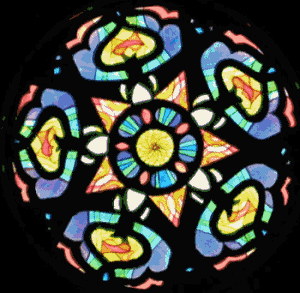 |
||
|
Dissolving view. Nightfall. |
 |
Chromatrope-patterns. |
|
| A soldiers dream. Six magic lantern slides in a mahogany frame measuring 16.5 x 10 cm are used for this effect. Below only two from the five visions are shown. |
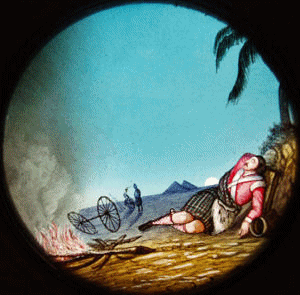 |
||
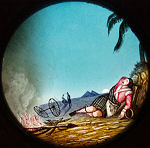 +
+
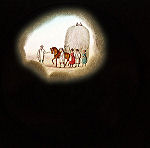 =
=Effect slide. |
|||
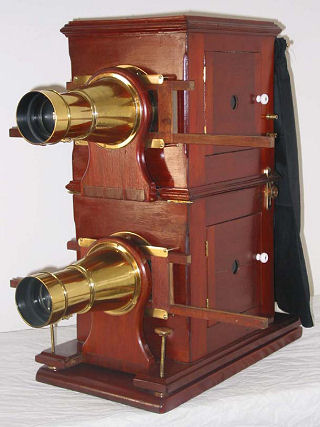 |
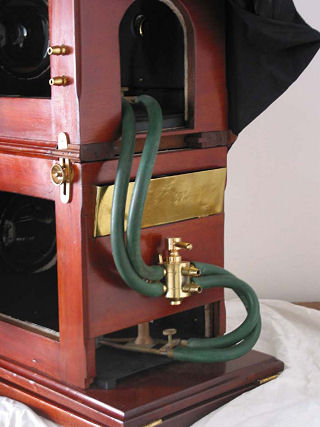 |
||
|
Simple, but very beautiful, biunial
made by an unknown manufacturer. The right image shows well how the gas
lighting worked. The gas supply to both lamps went through a brass
distributor. When one lamp got more gas the other automatically got
less. By doing so the most beautiful dissolving views could be realized.
It happened many times that such a lantern caught fire or exploded
during the show. That's why modern lanternists prefer halogen light. |
|||
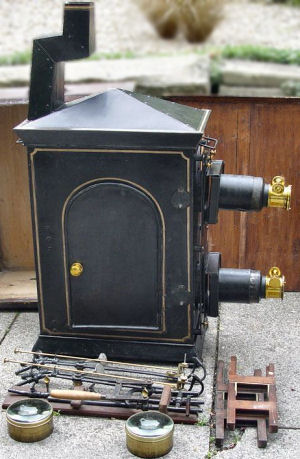 |
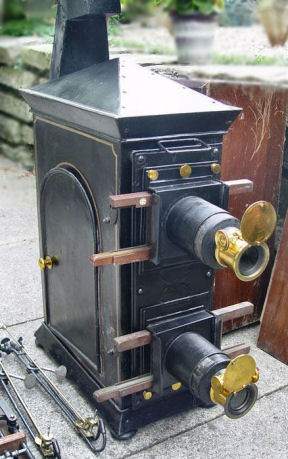 |
||
|
Most biunials are made of wood,
some of metal, like this special double magic lantern, complete with an
eye-catching twice bended chimney. In front of the lanterns we see the
two condensers, a pair of limelight-burners
for lighting, and a couple of Beard slide
carriers made by mahogany and brass. This lantern is probably made
in France. The lantern is 66 cm tall without the chimney. It is 63.5 cm
long with pushed in lenses and 25.5 cm wide. |
|||
 |
Besides the double magic lantern,
the biunial, also tripple lanterns exist, the triunials. Those lanterns
consist of two parts from which the upper part can be removed by
unscrewing the four screws at the top of the lower part. Now the lower
part can be used as a biunial using the roof and chimney of the complete
lantern. All six doors are supplied with a small cobalt blue window. The open back is screened off by a red velvet curtain. Each brass optical system is composed of three telescopic extensible parts; the focal distance of the lenses is 7" (18 cm) and focussing takes place by a 'rack and pinion' system in front of the lens. Height 89 cm, length (with pushed in lenses) 51 cm, width including the handles) 30.5 cm. |
||
 |
Of course also a couple of identical magic lanterns can be used for
creating dissolving views and other optical effects. This set is
composed of a wooden chest that contains a pair of magic lanterns made
by
Brevette, complete with a threefold oil lamp, a condenser and a brass
lens plated with nickel. The lanterns can be placed on top of the chest and are fixed on place by means of brass screws. In front of the chest a dissolver system is assembled with toothed edges for a smooth result. The height of the butterfly shaped mechanism can be adjusted to the position of the lenses. Dimensions of the chest: 51 cm long and 41 cm wide. |
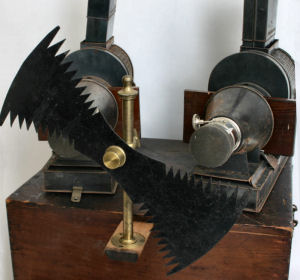 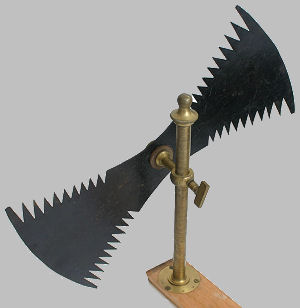 |
|
|
Another system for creating dissolving views. |
 |
||
| Select another sort of magic lantern by clicking one of the images below: | |||||
 |
 |
 |
 |
 |
 |
| |
©1997-2021 'de Luikerwaal' All rights reserved. Last update: 10-05-2021. |
|